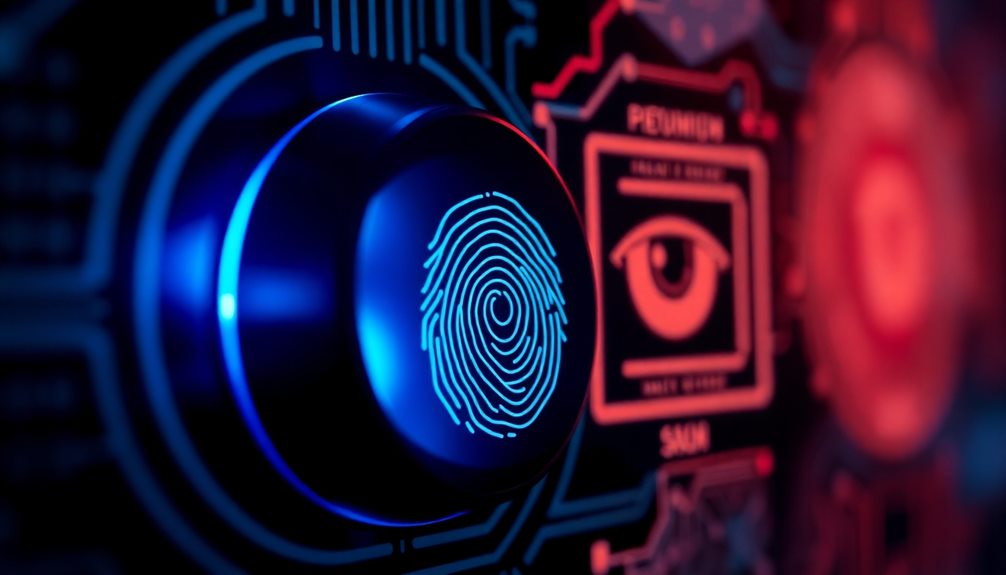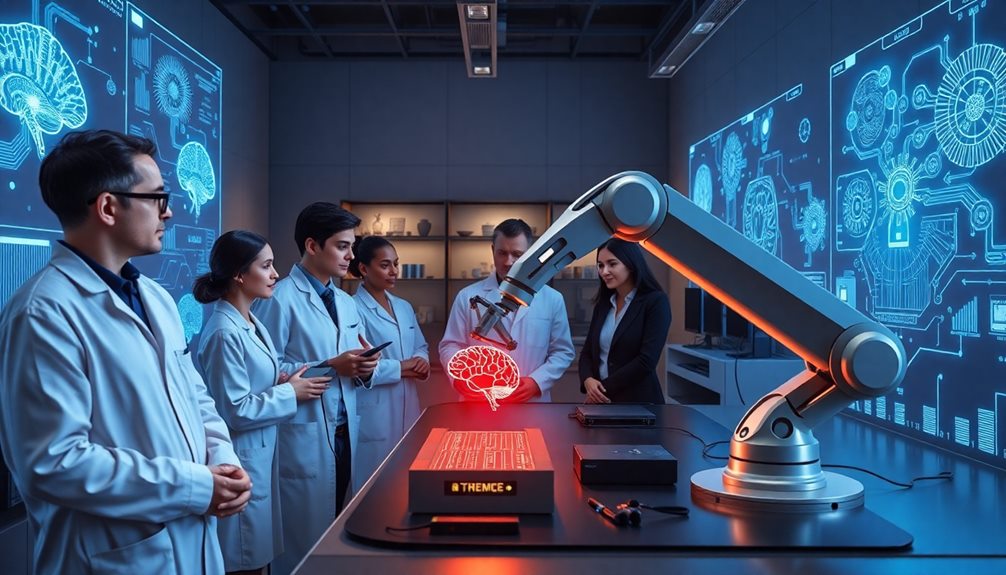Biometric authentication services use unique physical and behavioral traits to boost security and simplify identity verification. You can access systems with your fingerprint, face, or even voice, making it hard for anyone to replicate your identity. These services are increasingly essential in finance and healthcare, where multi-factor authentication with biometrics can improve user recognition rates greatly. They also focus on strong encryption and user control to protect your data and build trust. If you're curious about how these systems can work for you, there's plenty more insights to explore on the evolving world of biometric technologies.
Key Takeaways
- Biometric authentication uses unique physical and behavioral traits, enhancing identity verification and reducing fraud risks in various sectors like finance and healthcare.
- Types of biometric technologies include fingerprint scans, facial recognition, iris recognition, voice recognition, and behavioral monitoring for ongoing user authentication.
- Strong encryption and user control over biometric data protect privacy and build trust, ensuring compliance with regulatory standards.
- Integration challenges with legacy systems can be resolved through advanced APIs and custom strategies for seamless transitions to biometric solutions.
- Multi-factor authentication (MFA) with biometrics significantly increases security, achieving high user recognition rates while supporting user-friendly designs for better accessibility.
Overview of Biometric Authentication
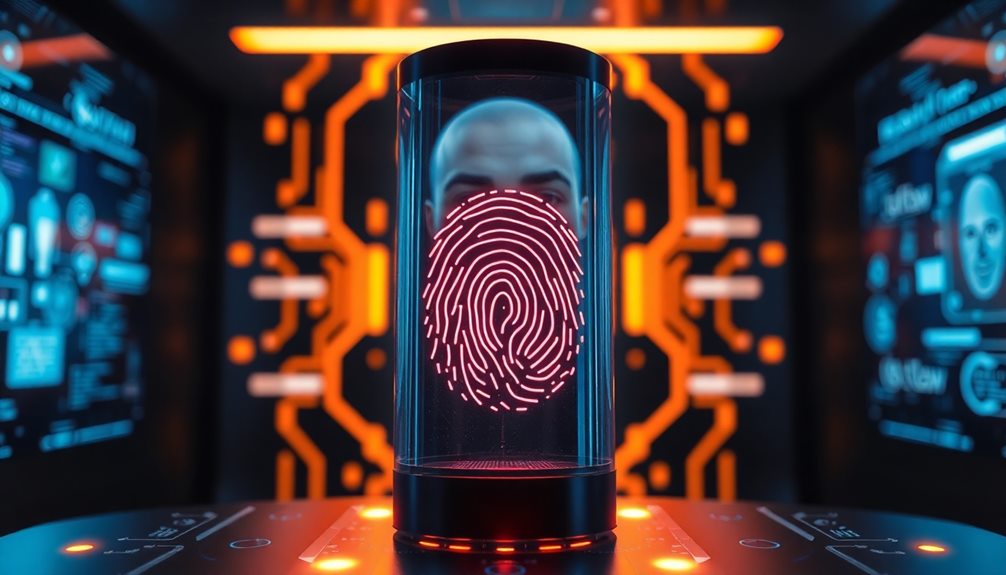
Biometric authentication, which relies on unique physical and behavioral traits, offers a level of security that's hard to match with traditional passwords. By leveraging physiological biometrics like fingerprints and facial recognition, it guarantees that only you can access your information. This method enhances identity verification, making it nearly impossible for someone to replicate your access credentials.
As user consent becomes increasingly important in digital security, biometric authentication provides a solution that respects privacy while guaranteeing robust protection.
Behavioral biometrics, on the other hand, focuses on your individual patterns, such as keystroke rhythm and mouse movements. This adds an additional layer of security, as it continuously monitors your behavior to confirm it aligns with your established patterns.
Many sectors, including finance and healthcare, are increasingly adopting biometric authentication as their primary or multi-factor authentication method. Continuous authentication allows systems to detect anomalies in real time, potentially revoking access if suspicious behavior is observed.
The integration of biometric technologies with mobile devices and cloud services is on the rise, driven by advancements in AI and machine learning. These innovations are improving both the accuracy and user experience, guaranteeing that your data remains secure while providing a seamless way to authenticate your identity.
Types of Biometric Technologies
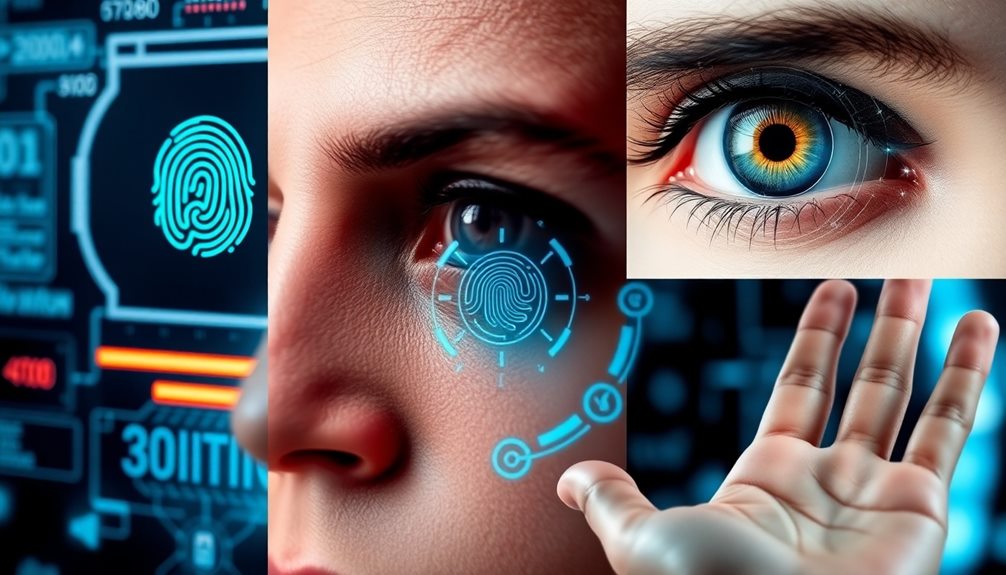
A variety of biometric technologies are transforming how we authenticate identities. One of the most popular methods is the fingerprint scan, which you often use on smartphones and security systems for quick access. It utilizes unique patterns in your fingerprints, ensuring a fast and reliable authentication process.
Additionally, these technologies can enhance customer interactions through personalized responses, as seen in AI in Business. Facial recognition is another innovative technology, employing advanced algorithms and cameras to identify users based on distinct facial features, increasingly found in security and mobile applications.
Iris recognition offers a higher level of accuracy by capturing high-resolution images of your iris, which has unique patterns that are hard to replicate. Similarly, voice recognition analyzes your vocal characteristics and patterns, making it particularly useful in environments like call centers and smart devices where hands-free access is essential.
Lastly, behavioral biometrics continuously monitors your actions, such as typing rhythm and mouse movement. This ongoing authentication method enhances fraud detection by analyzing deviations from your established behavior patterns.
Each of these biometric technologies provides a unique approach to identity verification, making them indispensable in today's security landscape.
Security and Privacy Considerations
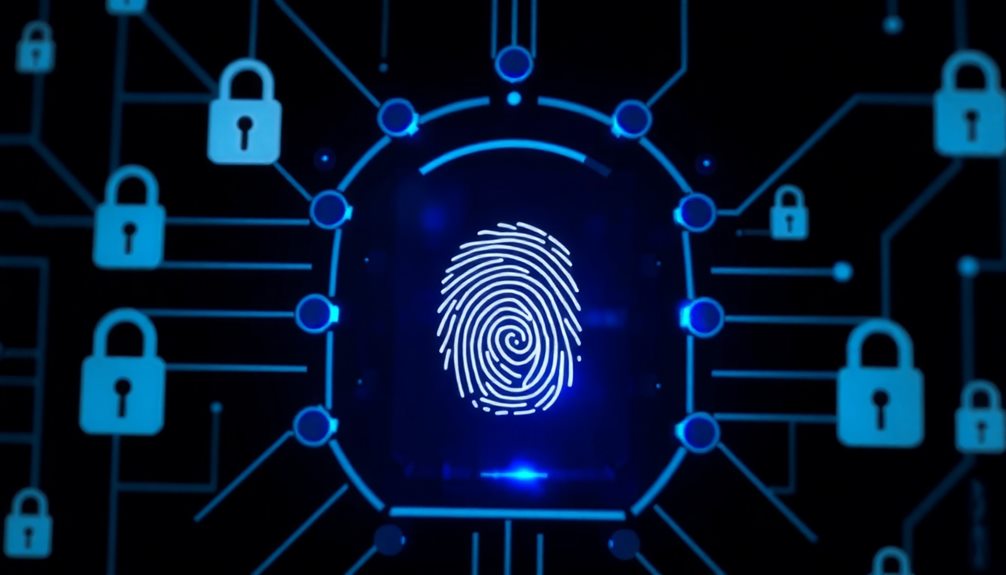
When it comes to biometric authentication, protecting your sensitive data is vital.
Implementing strong encryption standards, similar to those used in Google Pay security measures, can help safeguard your biometric information from unauthorized access.
Additionally, having control over your data, such as choosing whether to opt in or out, enhances your privacy and builds trust in these systems.
Data Protection Measures
As organizations increasingly adopt biometric authentication systems, it's vital to implement stringent data protection measures to safeguard sensitive information. You need to prioritize the following aspects:
- Secure storage: Utilize encryption methods to protect biometric data from unauthorized access, minimizing the risk of identity theft.
- Regulatory compliance: Confirm your security framework meets industry standards, balancing user convenience with the privacy of biometric data.
- User control: Provide options for users to opt-in or opt-out of biometric data collection, enhancing transparency and trust.
- Continuous monitoring: Regularly assess biometric systems to detect anomalies in user behavior, allowing for prompt access revocation if deviations occur.
- Ongoing assessment: Stay updated on the evolution of biometric technologies and continuously evaluate security measures to mitigate risks associated with data breaches.
These measures are critical not only for safeguarding the protection of biometric data but also for maintaining user confidence in the authentication process.
User Control Options
Implementing user control options is essential for ensuring security and privacy in biometric authentication systems. You should have the ability to manage your biometric data through opt-in and opt-out features, empowering you to decide how your information is used. This control not only protects your privacy but also fosters trust in the system.
To enhance transparency, organizations must keep you informed about the collection, use, and storage of your biometric data. This clarity is key to building confidence in biometric technologies.
Additionally, biometric systems must offer user-friendly management interfaces, allowing you to easily review, update, or delete your data as needed.
Balancing user convenience with effective privacy protection is critical for compliance with regulations. When you feel secure in managing your biometric data, it encourages responsible usage of these systems.
Secure storage and advanced encryption methods are essential to safeguarding your data from unauthorized access and breaches, reinforcing the importance of these user control options.
Integration Challenges and Solutions
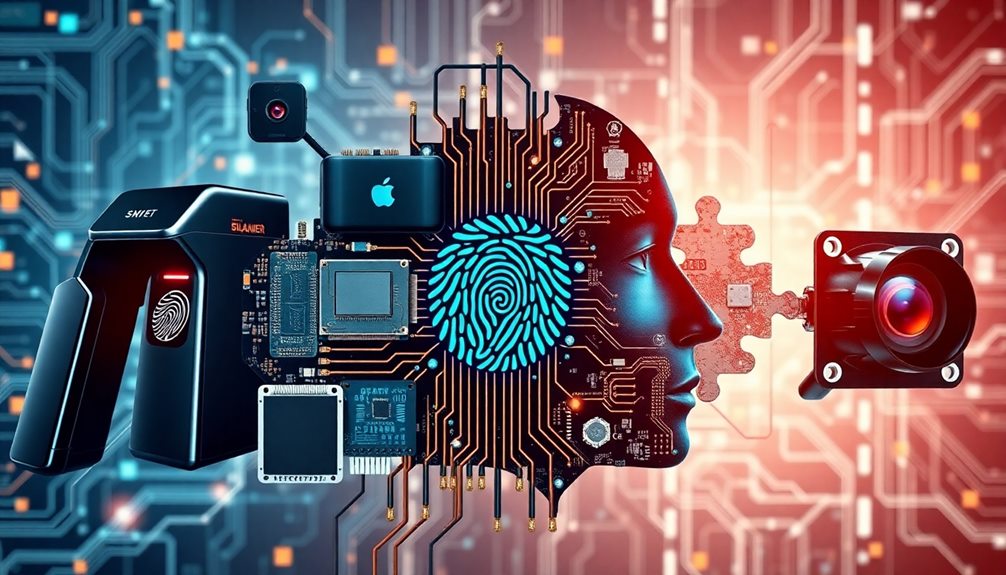
Integrating biometric authentication with your legacy systems can feel intimidating, but it doesn't have to be.
Thanks to advanced APIs and improved sensor technologies, you can achieve better compatibility and performance even in challenging environments.
Legacy System Compatibility
Legacy system compatibility poses significant challenges when it comes to adopting biometric authentication services. Many legacy systems utilize outdated technologies and security protocols that aren't compatible with modern biometric systems. This can hinder your organization's ability to implement secure authentication methods effectively.
However, there are solutions available to navigate these integration challenges:
- Advanced APIs: These are being developed to bridge the gap between newer biometric systems and older legacy frameworks.
- Custom integration strategies: Tailoring solutions to specific legacy systems can guarantee a smoother shift without disrupting existing operations.
- Innovative enrollment methods: These methods can secure the storage of biometric traits while maintaining user-friendliness, facilitating easier integration.
- Continuous improvements: Enhancements in sensor technology and algorithms allow biometric systems to perform well even in challenging environments.
- Identity and access management: Streamlining these processes can improve compatibility and enhance overall security.
Sensor Technology Improvements
With ongoing advancements in sensor technology, biometric authentication systems are becoming more accurate and reliable, even in challenging environments. Enhanced sensors can now capture high-quality biometric data under various lighting and temperature conditions, greatly reducing false rejections. This means you'll experience smoother and more dependable authentication processes.
Innovative sensor designs are being integrated into mobile devices, making advanced biometric authentication not just efficient but also user-friendly. You can easily access your devices with just a fingerprint or facial recognition, enhancing your overall security experience.
Additionally, the development of multi-modal sensors combines different biometric traits into a single device, offering greater convenience while addressing integration challenges.
To facilitate this shift, robust APIs and interfacing technologies are emerging, ensuring compatibility between advanced sensors and existing security protocols. This makes it easier for you to integrate new authentication solutions into various systems without major disruptions.
As these technologies continue to improve, you'll find that biometric authentication becomes an essential part of your daily interactions, providing enhanced security and peace of mind.
User Acceptance and Accessibility

User acceptance and accessibility are crucial factors in the successful implementation of biometric authentication services. To guarantee you and others embrace this technology, it's important to focus on several key aspects:
- User education: Informing users about the benefits of biometric authentication technology enhances acceptance rates.
- Transparency: Clear communication regarding data usage, including opt-in and opt-out options, builds trust and comfort.
- Accessibility features: Incorporating tools like voice and facial recognition guarantees inclusivity for users with disabilities.
- User-friendly design: Fast and simple systems lead to a positive user experience, increasing adoption rates.
- Continuous monitoring: Regularly adjusting biometric systems based on user feedback helps improve both acceptance and accessibility.
Multi-Factor Authentication With Biometrics

Combining biometric authentication with multi-factor authentication (MFA) greatly boosts security measures for your digital assets. This approach enhances protection by merging biometric verification, like fingerprints or facial recognition, with traditional methods such as PINs or passwords. As a result, unauthorized access becomes considerably more difficult.
The uniqueness of physiological traits makes them hard to replicate, ensuring a more secure user verification process. Additionally, incorporating behavioral biometrics allows for continuous user verification, analyzing your typing rhythm or mouse movements to detect any anomalies in real time. This proactive monitoring can further mitigate risks associated with identity theft.
Studies reveal that organizations employing MFA with biometrics report up to a 91% good user recognition rate, considerably reducing the chances of fraud. As sectors like finance and healthcare increasingly adopt these systems, they're not just complying with stringent regulations but also fostering greater user trust through robust security measures.
In a world where cyber threats are ever-present, implementing MFA with biometrics is a smart move to safeguard your sensitive information and maintain peace of mind.
Cost and Scalability of Solutions

As organizations seek to enhance their security, understanding the cost and scalability of biometric authentication solutions becomes essential. The initial implementation costs can be substantial, depending on the complexity and scope of the solution.
However, long-term operational costs often decrease due to reduced fraud and enhanced security.
Biometric systems are inherently designed for scalability, allowing you to adjust security measures as your user base grows without greatly increasing expenses.
Here are key points to reflect upon:
- Cost-Effective: Long-term savings from reduced fraud.
- Scalable Solutions: Easily accommodate user growth.
- Biometrics-as-a-Service (BaaS): Access technology without large upfront costs.
- Advanced Solutions: Utilize AI and machine learning for efficiency.
- Future Trends: Costs are expected to decrease as technology evolves.
Performance and Accuracy Metrics
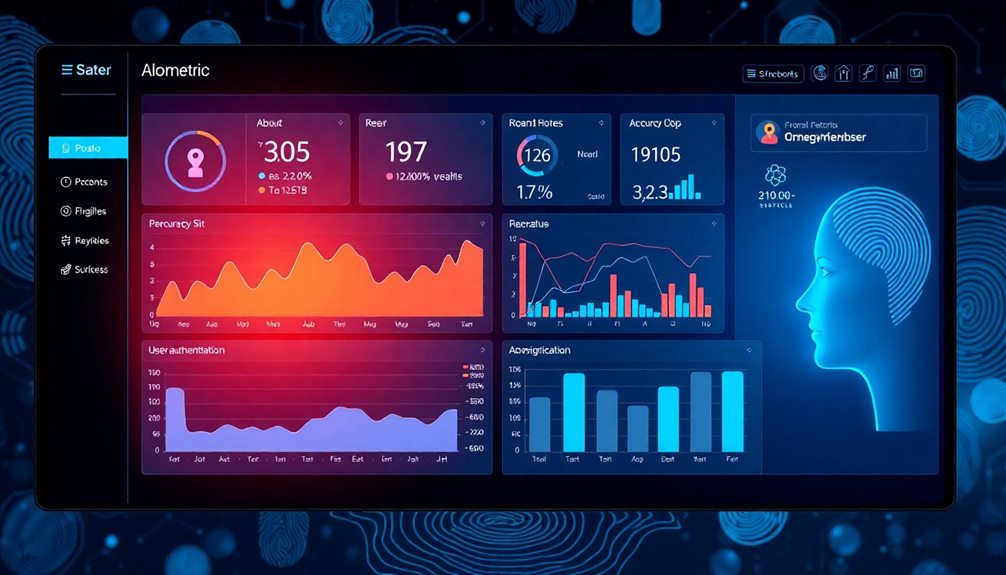
When evaluating biometric authentication systems, performance and accuracy metrics play an essential role in their effectiveness. You'll find that these metrics not only reflect the reliability of user verification but also demonstrate the system's capability to prevent unauthorized access. For instance, many biometric systems achieve a remarkable 99% good user recognition rate, particularly in banking institutions, showcasing their high accuracy rates.
Through continuous monitoring and machine learning algorithms, these systems adapt to changes in user behavior, further improving their accuracy over time. Significantly, high-resolution biometric data capture, such as iris scans, can exceed 99% accuracy, making them a reliable method for identity verification. Below is a summary of key performance metrics:
| Metric | Value | Importance |
|---|---|---|
| Good User Recognition | 99% | High accuracy in verification |
| Block Rate | 100% | Prevents automated attacks |
| Iris Scan Accuracy | >99% | Reliable identity verification |
This combination of advanced algorithms and high-quality data capture guarantees that biometric systems maintain their effectiveness in security and user verification.
Future Trends in Biometric Authentication
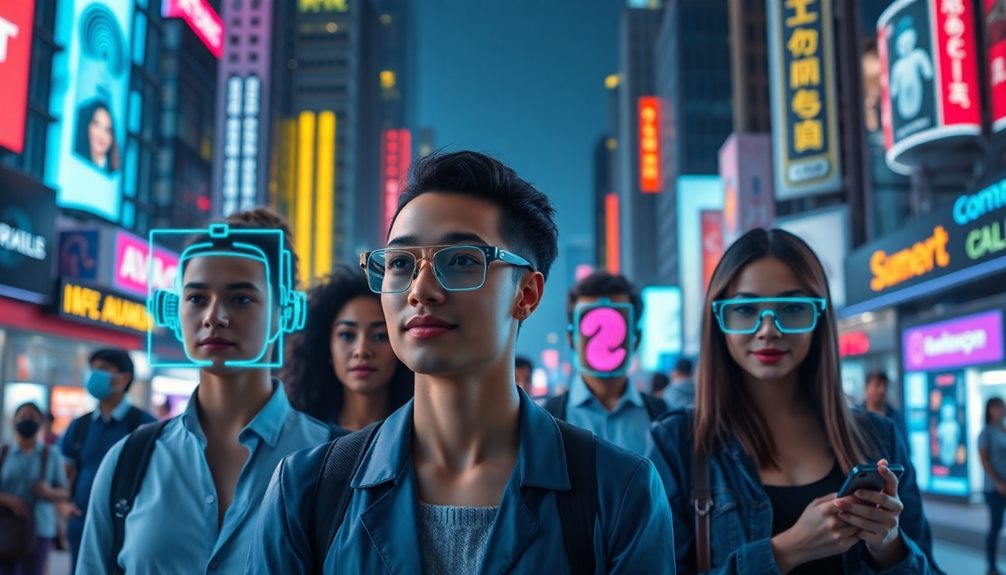
The future of biometric authentication is poised for significant evolution with the integration of artificial intelligence and machine learning.
These technologies will enhance accuracy and security, improving real-time data processing and anomaly detection. You'll see a shift towards more advanced systems that guarantee seamless user experiences while maintaining robust security.
Here are some future trends to expect in biometric authentication:
- Increased use of multi-factor authentication (MFA) combining biometric methods with traditional security measures.
- Expansion of biometric applications into industries like retail and travel for secure and user-friendly access.
- Rise of non-invasive biometric methods, such as behavioral biometrics and voice recognition, offering convenience and high security.
- Development of mobile-optimized biometric solutions, making secure access easier on handheld devices.
- Focus on unique biometric traits that enhance personalization and security for users.
As these trends unfold, you can anticipate a future where accessing your accounts and services becomes faster and more secure, making biometric authentication an integral part of your digital life.
Frequently Asked Questions
What Are the 5 Main Types of Biometric Authentication?
You'll find five main types of biometric authentication: fingerprint scanners, facial recognition, iris recognition, voice recognition, and behavioral biometrics. Each method offers unique benefits and enhances security in various applications, making access easier for you.
How Much Does Biometric Authentication Cost?
You get what you pay for, and biometric authentication costs can vary widely. Initial investments might reach thousands, with ongoing fees averaging 15-20% annually, but the potential savings and security often outweigh those costs.
What Is the Best Biometric Authentication System?
Choosing the best biometric authentication system depends on your needs. Look for options that combine various methods like fingerprints and facial recognition, ensuring strong security while providing a seamless user experience for easy access.
What Does Biometric Authentication Do?
Imagine your fingerprint throwing a party, only letting trusted guests in. That's biometric authentication! It verifies your identity through unique traits, making it tougher for impostors to crash the event and steal your secrets.
Conclusion
As biometric authentication continues to evolve, you might wonder if it's truly the future of secure identity verification. The reality is, while these technologies offer enhanced security and convenience, issues like privacy concerns and integration challenges still exist. However, by addressing these hurdles, you can expect biometrics to become even more reliable and widely accepted. So, are you ready to embrace this innovative approach to security, or do you still have reservations? Your choice could shape the future of authentication.
